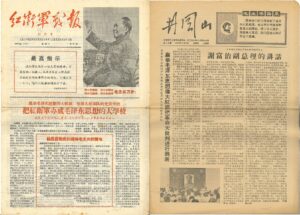At the height of the Cultural Revolution, Red Guard tabloids were ubiquitous. And yet, they don’t appear in Chinese statistics. They had their heyday from 1966-1968, but after the forceful dissolution of the Red Guard movement, the Party withdrew their approval of the tabloids as well, and they disappeared from the official account of the Cultural Revolution. Why did that happen? I argue that this “disappearance” reflects a retroactive application of the Party’s preferred definition of what a newspaper is and should be.
The death of newspapers?
Here is a puzzle. According to the China Statistical Yearbook (and about any other official source published in the People’s Republic), the number of Chinese newspapers crashed at the start of the Cultural Revolution (1966-1976). In 1965, 343 newspapers were published in China; a year later, just 49. The number of titles in circulation hit rock bottom in 1967, with just 43 papers left. Or that’s what official sources tell us.
But here’s another set of data: Scholars in Hong Kong, the U.S. and elsewhere have spent decades collecting “Red Guard tabloids” from the Cultural Revolution’s early years. A compendium published from 1999 through 2005 collects 3,155 titles in 112 massive volumes. And estimates of the number of such tabloids circulating during the Cultural Revolution run as high as 10,000.
So, what actually happened in 1966—did the number of Chinese newspapers implode, or rather explode?
Well, both. It all boils down to how you define “newspapers.” If you take People’s Daily as your standard, then the Red Guard tabloids may not qualify. Many of the official broadsheet papers, published by national, provincial, and city-level authorities, folded early in the Cultural Revolution. Red Guards—initially high school and university students, but increasingly also “rebel” factions within all sorts of work units—denounced the official papers as reactionary peddlers of propaganda for “capitalist roaders” and forced their closure.
Only a few survived, including a handful of newspapers with national-level importance, such as People’s Daily, the Liberation Army Daily, or the Shanghai-based but nationally read Wenhuibao. In addition, every provincial committee of the CCP kept one paper going, to serve their propaganda purposes. Pretty much all others shut down. Thus the nosedive.
Enter Red Guard tabloids
At the same time, the rapid proliferation of Red Guard organizations created enormous demand for new propaganda outlets, and the Red Guards accordingly started up their own publications—what became known as Red Guard tabloids. Some of these were crudely produced mimeographed pamphlets that appeared irregularly and were handed out to passers-by on street corners. But others were produced in a much more professional manner.
Often, Red Guard groups would take control of the printing plant of their work unit and order it to produce their new publications. With so many newspapers and journals shut down, there was ample capacity in printing shops and plants all over the nation, and this capacity (as well as the newsprint) was quickly put to use by the Red Guards. A significant portion of these papers, hence, were produced with high quality equipment, on the same machines and, ironically, by the same workers who, until recently, had produced the state-sanctioned papers.
Copies of these tabloids are ubiquitous today on flea markets, attesting to their wide spread and readership during the Cultural Revolution. The Red Guard tabloids, as I have argued in a recent article published in The China Quarterly, hence were an essential part of the Chinese press landscape during the Cultural Revolution.
Not so different, after all
The language of the Red Guard papers was shrill, to say the least. They were preoccupied with exposing their enemies’ “crimes” and attacking other groups. And the turbulent times usually precluded a regular publication schedule. But many kept going for years, publishing dozens or even hundreds of issues, with print runs in the tens of thousands.
Intriguingly, the Red Guard tabloids were not that different from the “official” papers published during the Cultural Revolution. Dig out any issue of People’s Daily from 1967 and you see what I mean. The language of the CCP’s national mouthpiece was just as shrill and repetitive as the denunciations filling the pages of the Red Guard press; and People’s Daily resorted to amply quoting Chairman Mao and, since 1966, to set these quotations in bold print—no different from the Red Guard papers. And speak of (lack of) frequency of issues—it had been Red Flag, the CCP’s theoretical organ, that had set the precedent in the 1950s and 1960s with its irregular publication schedule.
Who decides what counts?
Why, then, are the Red Guard papers, despite their enormous numbers and ubiquity, banished from all official accounts of China’s newspaper history? It’s very much a political decision. The CCP enacts full control over the press; no newspaper is allowed to appear without official approval. And this control is extended backwards to history.
The Red Guard papers were grassroots publications, launched by Red Guard organizations that were spontaneously formed and lacked official sanction (other than Mao’s public praise, that is). In other words, they were technically independent—outside of the Propaganda Department’s control regime. Any such publication, of course, would be unacceptable today. And this principle is applied, retroactively, to history.
So the Red Guard papers don’t count, made to disappear from official statistics. It’s up to us to accept—or reject—the government’s official definition of what counts as a newspaper.



